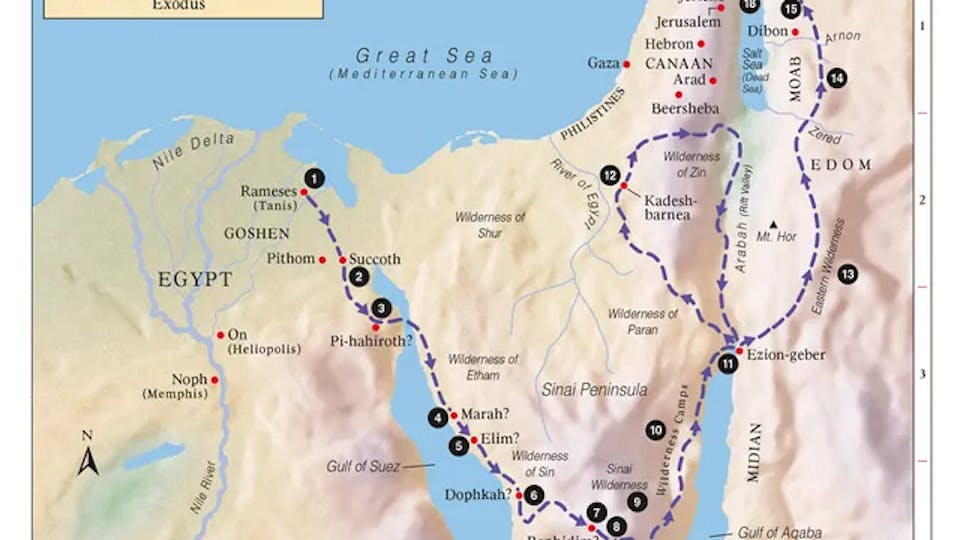Retracing the Steps: The Israelites' Journey from Egypt to Canaan

Imagine the heat of the desert sun beating down as weary feet press into shifting sand. A nation once bound in slavery begins a slow, uncertain march toward freedom, led not by compass or command, but by a pillar of cloud by day and fire by night. This is no ordinary expedition; it is the unfolding of a divine promise, centuries in the making.
When we trace the Israelites' journey from Egypt to Canaan on a map, we don’t just uncover a route, we step into a sacred story of perseverance, purpose, and providence. A story where every stop in the wilderness carried meaning, and every detour revealed a lesson.
“The LORD went before them by day in a pillar of cloud to lead them along the way…” Exodus 13:21
Today, this ancient path continues to speak, inviting believers, scholars, and travelers to walk in the footsteps of faith. Whether through Scripture or through the land itself with Sar-El Tours, the journey from Egypt to Canaan remains a powerful reflection of God's leading hand through every wilderness we face. In this article, we will explore a map of the Israelites' journey from Egypt to Canaan.
Why This Journey Still Matters Today
The exodus route map from Egypt to Canaan transcends its historical significance to become a timeless metaphor for the spiritual journey we all undertake. This ancient path from bondage to promise resonates across millennia because it mirrors our deepest human experiences.
First, it speaks to our universal longing for freedom. The Israelites' departure from Egypt, a dramatic break from generations of slavery, echoes in every heart that has ever yearned for liberation. As Moses declared to Pharaoh, "Let my people go, that they may serve me" (Exodus 8:1). This journey reminds us that true freedom isn't merely the absence of chains but the presence of purpose.
Second, the route from Egypt to Canaan illustrates the transformative space between the promise given and the promise fulfilled. God had sworn to Abraham: "And I will bring you to the land I swore with uplifted hand to give to Abraham, to Isaac and to Jacob" (Exodus 6:8). Yet between the divine oath and its realization stretched a wilderness journey, a space where faith was tested, character was formed, and divine provision was experienced daily.
For modern believers, this journey offers profound parallels to spiritual growth. The Israelites left Egypt in a single night, but it took forty years to prepare them for Canaan. Similarly, while salvation may come in a moment, becoming who God intends us to be is a lifelong pilgrimage.
Perhaps most powerfully, this journey matters because it reveals God's character. Through pillars of cloud and fire, manna in the morning, and water from rock, we witness a God who guides, provides, protects, and persists with His people—even through their failures and complaints. As Nehemiah later reflected: "Because of your great compassion, you did not abandon them in the wilderness" (Nehemiah 9:19).
Today, whether studying biblical narratives or walking the actual terrain with expert guides, this journey continues to illuminate our understanding of both divine faithfulness and human frailty. It teaches us that the path to our promised destinations rarely follows a straight line, yet every detour serves a purpose in the Master's hand.
Map Overview: The Route from Egypt to Canaan

The geographic progression of the Israelites' journey represents one of history's most significant migrations, a complex route shaped by divine guidance, natural barriers, and human choices. While scholars continue to debate exact locations, the biblical journey map narrative provides key waypoints that help us trace their path.
Goshen to the Red Sea: A Step Toward Freedom
The journey began in Goshen, the fertile Nile Delta region where the Israelites had lived for generations. Exodus 12:37 tells us, "The Israelites journeyed from Rameses to Sukkoth." Rameses (likely the city Pi-Ramesses in the eastern Delta) served as their departure point, with Sukkoth marking their first encampment.
From Sukkoth, rather than taking the direct coastal route through Philistine territory, "God led the people around by the desert road toward the Red Sea" (Exodus 13:18). This strategic detour brought them to their famous crossing point, traditionally placed at the Gulf of Suez or one of the northern lake systems of the Sinai Peninsula.
The crossing of the Red Sea (Yam Suph in Hebrew) marked both their definitive break from Egypt and their first major experience of divine intervention. On the eastern shore, at a location biblical scholars identify as possibly Marah, the Israelites celebrated with the Song of Moses: "The LORD is my strength and my defense; he has become my salvation" (Exodus 15:2).
Mount Sinai: Covenant and Commandments
After journeying through the Wilderness of Sin and stopping at Rephidim (where water miraculously flowed from the rock), the Israelites arrived at the foot of Mount Sinai approximately three months after leaving Egypt. While several mountains vie for recognition as the biblical Sinai, traditional identification places it at Jebel Musa in the southern Sinai Peninsula.
This sacred mountain represents perhaps the most spiritually significant stop on their journey. Here, amid thunder and lightning, God established His covenant with Israel and delivered the Ten Commandments. "Now if you obey me fully and keep my covenant, then out of all nations you will be my treasured possession" (Exodus 19:5).
The Israelites remained encamped at Sinai for nearly a year, a period of profound spiritual and national formation. Here, the tabernacle was constructed, the priesthood established, and the detailed laws that would govern their community were received. This extended stay transformed a fleeing slave population into a covenant nation with divine purpose.
Wandering in the Wilderness: A Detour of the Heart
From Sinai, the people journeyed northward through the wilderness of Paran, eventually reaching Kadesh-Barnea near the southern border of Canaan. This location proved pivotal in their journey. From here, Moses sent twelve spies to explore the Promised Land. Their subsequent report, with only Joshua and Caleb expressing faith that God would give them victory, led to Israel's greatest detour.
"The LORD's anger was aroused that day and He swore an oath, saying, 'Because they have not followed me wholeheartedly, not one of those who were twenty years old or more when they came up out of Egypt will see the land I promised on oath to Abraham, Isaac and Jacob'" (Numbers 32:10-11).
What should have been an eleven-day journey from Sinai to Canaan (Deuteronomy 1:2) expanded into forty years of desert wandering. The Israelites' journey from Egypt to Canaan map tells not just a route, but a revelation of how disbelief can extend our distance from promise.
During these wilderness years, the Israelites followed a circuitous path through the Sinai and Negev deserts, with locations mentioned in Numbers 33 including Ezion-geber (near modern Eilat) and eventually returning to Kadesh. Archaeological evidence suggests they likely maintained a semi-nomadic lifestyle, following seasonal water sources across the region.
Final Approach: From Kadesh to Canaan
In the fortieth year, with the unbelieving generation now gone, Israel began their final approach to the Promised Land. Rather than entering directly from the south, they requested passage through Edom (modern southern Jordan). When this was refused, they traveled "along the route to the Red Sea, to go around Edom" (Numbers 21:4), eventually circling eastward through Moab.
Their path took them around the Dead Sea's eastern shore, through territories of ancient Moab and Ammon, until they reached the plains of Moab across the Jordan River from Jericho. Here, Moses delivered his final addresses (recorded in Deuteronomy) before climbing Mount Nebo for a glimpse of the Promised Land he would not enter.
The final leg of their forty-year journey came under Joshua's leadership. After crossing the miraculously parted Jordan River, they conquered Jericho, their first victory in Canaan, and began fulfilling the promise made generations earlier to Abraham.
Faith Lessons from the Route
The physical landmarks of the Israelites' journey map perfectly onto the spiritual topography of faith. Each location, each struggle, and each divine intervention offers profound lessons for our own wilderness wanderings.
The Red Sea: Facing Impossible Barriers
Standing at the Red Sea with Egyptian chariots approaching from behind, the Israelites faced what seemed an impossible situation. Moses' command rings through the centuries: "Do not be afraid. Stand firm and you will see the deliverance the LORD will bring you today" (Exodus 14:13).
This pivotal moment teaches us that faith sometimes means moving forward when there appears to be no way forward. The waters parted only after Moses raised his staff, and the people began their march. Our own "Red Sea moments", those impossible situations where retreat seems our only option, often become the birthplace of our greatest testimonies.
Manna in the Wilderness: Daily Dependence
For forty years, the Israelites experienced supernatural provision, manna each morning, just enough for the day. This daily bread taught them dependence in a way that stockpiled resources never could. As Moses later explained: "He humbled you, causing you to hunger and then feeding you with manna... to teach you that man does not live on bread alone but on every word that comes from the mouth of the LORD" (Deuteronomy 8:3).
The manna challenge, trusting God for tomorrow's provision while today's needs are met, remains one of faith's most difficult lessons. Yet this daily dependence fosters an intimacy with God that self-sufficiency never can.
The Golden Calf: The Danger of Impatience
While Moses communed with God on Sinai, the people grew impatient and crafted a golden calf. This tragic episode reveals how quickly we can abandon divine guidance when results aren't immediate. The golden calf stands as a warning about creating substitute gods when the true God seems silent or slow.
Perhaps most striking is that this apostasy came shortly after witnessing the Red Sea's parting and while God's cloud still hovered over the mountain. Even miraculous experiences don't guarantee sustained faith, a sobering reminder that spiritual memory can be surprisingly short.
Water from Rock: Finding Provision in Unlikely Places
Twice during their journey, the Israelites received water from the rock in seemingly barren places. These miracles teach us that God's provision often comes from unexpected sources. As the psalmist later marveled: "He split the rocks in the wilderness and gave them water as abundant as the seas" (Psalm 78:15).
In our own spiritual journeys, the places of greatest scarcity, whether emotional, financial, or relational, can become surprising fountains of God's grace. The wilderness, rather than being God-forsaken, often becomes God-revealing.
Kadesh-Barnea: The Crossroads of Belief
At Kadesh-Barnea, ten spies saw giants while two saw opportunity. Same landscape, different vision. This pivotal moment demonstrates how perspective shapes destiny. While the majority saw themselves as "grasshoppers" compared to Canaan's inhabitants, Joshua and Caleb declared: "Do not be afraid of the people of the land, because we will devour them. Their protection is gone, but the LORD is with us" (Numbers 14:9).
The Kadesh lesson remains perhaps the journey's most poignant: our perception of obstacles reveals more about our view of God than about the obstacles themselves. Standing at our own crossroads of decision, how we see challenges directly impacts whether we enter our promised territory or circle back into wilderness.
Walking Your Own Journey of Faith
Contact your travel agent today to request a trip with Sar-El Tours. Don't yet have a travel agent? We can put you in touch with a local provider. Contact us today and come and experience the Bible not just as a book but as a living, breathing land beneath your feet.